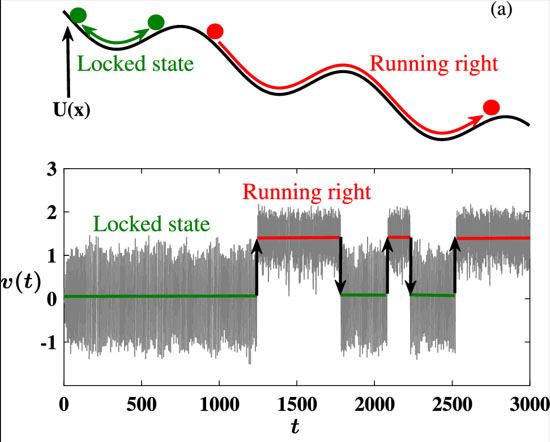| May 26, 2023 |
Active Brownian particles have four distinct states of motion
(Nanowerk News) Active Brownian motion describes particles which can propel themselves forwards, while still being subjected to random Brownian motions as they are jostled around by their neighbouring particles.
|
|
Through new analysis published in EPJ E ("Active Brownian particles in a biased periodic potential"), Meng Su at Northwestern Polytechnical University in China, together with Benjamin Lindner at Humboldt University of Berlin, Germany, have discovered that these motions can be accurately described using four distinct mathematical patterns.
|
 |
| Switching between locked and running states.
|
|
Active Brownian particles can be found across a diverse array of scenarios in nature: from sub-cellular structures pulled along by biomolecular motors, to movements of entire herds of animals, which can act collaboratively to find food or evade predators more easily. Recently, researchers developed artificial particles which behave in strikingly similar ways to their natural counterparts – presenting exciting new opportunities in medicine robotics, and many other fields of cutting-edge research. Ultimately, Su and Lindner’s discoveries could lead to fascinating new insights into how these systems behave.
|
|
The motions of Active Brownian particles are already known to depend on the friction they experience, as well as external bias forces, which skew their paths in specific directions. Using computer simulations active Brownian systems, backed up by simple calculations, Su and Lindner discovered that variations in these two parameters can force the systems into one of four possible states.
|
|
When a balance emerges between biased active driving forces, and the friction experienced by a particle, it will enter a ‘locked’ state – confining its motion to a small region. When its driving force instead dominates over friction, the particle will move persistently in a mostly straight line: entering a ‘driving’ state. Alternatively, the particle can switch back and forth between locked and running states, or between two different running states. When the system is subjected to random noise, the average speed of the particles will change depending on the intensity of the noise – but their motions still stay in one of these four states.
|

